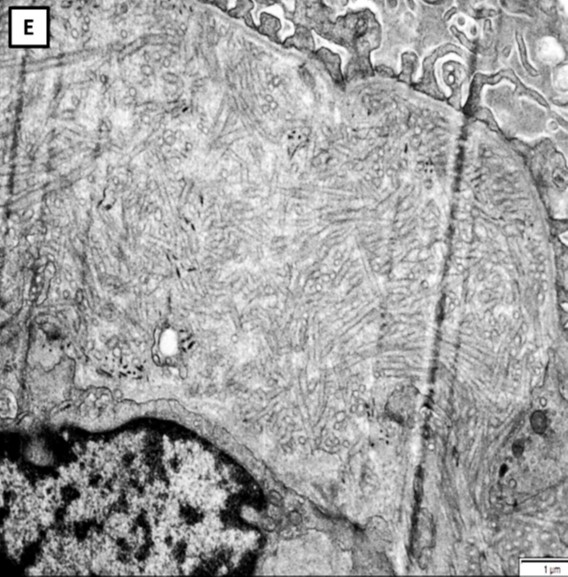โรคไตอักเสบชนิดอิมมูโนแท็กตอยด์: รายงานผู้ป่วย และทบทวน วรรณกรรม
Main Article Content
บทคัดย่อ
โรคไตอักเสบชนิดอิมมูโนแท็กตอยด์ (immunotactoid glomerulopathy: ITG) เป็นโรคโกลเมอรูลัสที่พบได้ไม่บ่อย ส่วนใหญ่พบในชาวตะวันตกผิวขาวถึงร้อยละ 90 พบในช่วงอายุ 50-70 ปี ยังไม่ทราบกลไกในการเกิดโรคที่ชัดเจน แต่พบว่าสัมพันธ์กับการมีโรคกลุ่มความผิดปกติของไขกระดูกและการสร้างเม็ดเลือด อาทิ lymphoproliferative disorder หรือ monoclonal gammopathy ผู้ป่วยส่วนใหญ่มาด้วยอาการบวม มีโปรตีนในปัสสาวะ เม็ดเลือดแดงออกมาในปัสสาวะ ความดันโลหิตสูง และภาวะไตเสื่อม มีการดำเนินโรคเป็นแบบค่อยเป็นค่อยไปเป็นระยะเวลาหลายปีกว่าจะเข้าสู่ภาวะไตเรื้อรังระยะสุดท้าย การักษาอ้างอิงตามโรคที่มีความผิดปกติของไขกระดูกและการสร้างเม็ดเลือดของผู้ป่วยเป็นหลัก ไตมีการตอบสนองต่อการรักษาที่ดี รายงานผู้ป่วยเป็นผู้ป่วยชายไทยอายุ 57 ปี มีโรคประจำตัวเป็นความดันโลหิตสูง และไขมันในเลือดสูง มาด้วยอาการบวม 6 เดือนก่อนมาโรงพยาบาล ความดันโลหิตสูงควบคุมได้ยากขึ้น ร่วมกับมีโปรตีนในปัสสาวะ และภาวะไตเสื่อม การตรวจทางพยาธิวิทยาของไตพบลักษณะเฉพาะที่เข้าได้กับโรคไตอักเสบชนิดอิมมูโนแท็กตอยด์ ตรวจเพิ่มเติมไม่พบโรคกลุ่มความผิดปกติของไขกระดูกและการสร้างเม็ดเลือด การรักษาในผู้ป่วยที่มีรายงานก่อนหน้านี้จึงอ้างอิงตามความเห็นของผู้เชี่ยวชาญเป็นหลัก
Article Details

อนุญาตภายใต้เงื่อนไข Creative Commons Attribution-NonCommercial-NoDerivatives 4.0 International License.
บทความนี้ตีพิมพ์ภายไต้การอนุญาต CC BY-NC-ND 4.0 ซึ่งอนุญาตให้สามารถใช้บทความนี้พื่อวัตถุประสงค์ใดๆ ก็ตามที่ไม่ใช่เชิงพาณิชย์ โดยต้องมีการอ้างถึงที่มาของบทความอย่างครบถ้วน ใครก็ตามสามารถคัดลอกและแจกจ่ายทุกส่วนของบทความนี้โดยไม่ต้องขออนุญาตจากผู้ประพันธ์หรือสมาคมโรคไตแห่งประเทศไทย
เอกสารอ้างอิง
Schwartz MM, Lewis EJ. The Quarterly case: nephrotic syndrome in a middle-aged man. Ultrastruct Pathol. 1980; 1(4):575-82.
Rosenstock JL, Markowitz GS, Valeri AM, Sacchi G, Appel GB, D’Agati VD. Fibrillary and immunotactoid glomerulonephritis: Distinct entities with different clinical and pathologic features. Kidney Int. 2003; 63(4):1450-61.
Bridoux F, Hugue V, Coldefy O, Goujon JM, Bauwens M, Sechet A, et al. Fibrillary glomerulonephritis and immunotactoid (microtubular) glomerulopathy are associated with distinct immunologic features. Kidney Int. 2002; 62(5):1764–75.
Bridoux F, Leung N, Hutchison CA, Touchard G, Sethi S, Fermand JP, et al. Diagnosis of monoclonal gammopathy of renal significance. Kidney Int. 2015; 87(4):698-711.
Alpers CE, Kowalewska J. Fibrillary glomerulonephritis and immunotactoid glomerulopathy. J Am Soc Nephrol. 2008; 19(1):34-7.
Fogo AB, Lusco MA, Najafian B, Alpers CE. AJKD Atlas of renal pathology: Immunotactoid กglomerulopathy. Am J Kidney Dis. 2015; 66(4):e29-30.
Nasr SH, Fidler ME, Cornell LD, Leung N, Cosio FG, Sheikh SS, et al. Immunotactoid glomerulopathy: clinicopathologic and proteomic study. Nephrol Dial Transplant. 2012; 27(11):4137-46.
Jain A, Haynes R, Kothari J, Khera A, Soares M, Ramasamy K. Pathophysiology and management of monoclonal gammopathy of renal significance. Blood Adv. 2019; 3(15):2409–23.
Nasr SH, Kudose SS, Said SM, Santoriello D, Fidler ME, Williamson SR, et al. Immunotactoid glomerulopathy is a rare entity with monoclonal and polyclonal variants. Kidney Int. 2021; 99(2):410-20.
Schwartz MM, Korbet SM, Lewis EJ. Immunotactoid glomerulopathy. J Am Soc Nephrol. 2002; 13(5): 1390-7.
Rosenmann E, Eliakim M. Nephrotic syndrome associated with amyloid-like glomerular deposits. Nephron. 1977;18(5):301-8.
Korbet SM, Schwartz MM. Immunotactoid glomerulopathy. Am J Kidney Dis. 1991; 17(3):247-57.
Jain S, Chhabra D. A case of immunotactoid glomerulopathy with rapid progression to end-stage renal disease. Scientific World Journal. 2009; 9: 1348-54.
Salvadori M, Tsalouchos A. New aspects of fibrillary and immunotactoid glomerulonephritis. EMJ Nephrol. 2019; 7(1):78-84.
Li C, Ruotsalainen V, Tryggvason K, Shaw AS, Miner JH. CD2AP is expressed with nephrin in developing podocytes and is found widely in mature kidney and elsewhere. Am J Physiol Renal Physiol. 2000; 279(4):F785-92.
Alpers CE, Kowalewska J. Fibrillary glomerulonephritis and immunotactoid glomerulopathy. J Am Soc Nephrol. 2008; 19(1):34-7.
Andeen NK, Yang HY, Dai DF, MacCoss MJ, Smith KD. DNAJ homolog subfamily B member 9 is a putative autoantigen in fibrillary GN. J Am Soc Nephrol. 2018; 29(1):231-9.
Ohashi A, Kumagai J, Nagahama K, Fujisawa H. Case of immunotactoid glomerulopathy showing high responsiveness to steroids therapy despite severe pathological features. BMJ Case Rep. 2019; 12(7):e229751.
Javaugue V, Dufour-Nourigat L, Desport E, Sibille A, Moulin B, Bataille P, et al. Results of a nation-wide cohort study suggest favorable long-term outcomes of clone-targeted chemotherapy in immunotactoid glomerulopathy. Kidney Int. 2021; 99(2):421-30.
Alpers CE, Rennke HG, Hopper J, Biava CG. Fibrillary glomerulonephritis: An entity with unusual immunofluorescence features. Kidney Int. 1987; 31(3):781-9.
Korbet S, Rosenberg F, Schwartz MM, Lewis EJ. Course of renal transplantation in immunotactoid glomerulopathy. Am J Med. 1990; 89(1):91-5.
Miki K, Sumida M, Iwadoh K, Honda K, Murakami T, Koyama I, et al. Recurrence of immunotactoid glomerulopathy with monoclonal IgG3к deposits after kidney transplant. Arch Organ Transplant 2017;2(1):015-018.
Carles X, Rostaing L, Modesto A, Orfila C, Cisterne JM, Delisle MB, et al. Successful treatment of recurrence of immunotactoid glomerulopathy in a kidney allograft recipient. Nephrol Dial Transplant. 2000; 15(6):897-900.
Sathyan S, Khan FN, Ranga KV. A Case of recurrent immunotactoid glomerulopathy in an allograft treated with rituximab. Transplant Proc. 2009; 41(9):3953-5.


